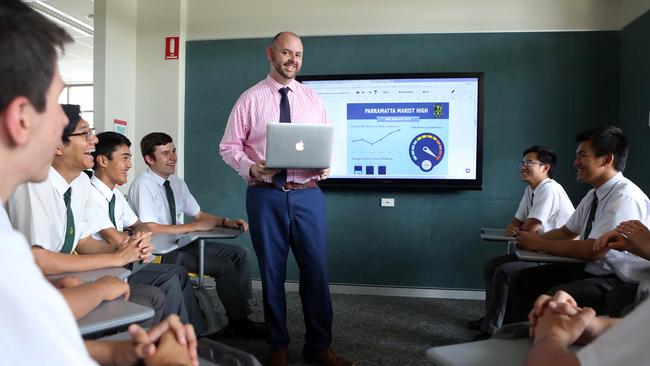Qualtrics system: schools and universities count on surveys
Australian schools and universities are finding new ways to measure student improvements and how they are learning.

Australian schools and universities are finding new ways to measure student improvements and how they are learning, as well as how education system leaders are evolving, through a survey-based research and insights company.
US-based Qualtrics, which established a base in Australia two years ago, has been known for setting up surveys to help companies provide 360-degree staff and leadership reviews, along with employee insights and customer data.
Qualtrics has been increasingly used in the corporate environment to help companies improve their operations, but it has not been used in schools in Australia until this year.
Asia-Pacific managing director Bill McMurray says the plan is to encourage schools to use a sophisticated platform to offer insights into how they can improve operations, rather than just using simple polls such as Survey Monkey.
“The surveys are not necessarily just for the students, it could be parents or the staff,” McMurray says. “It could be anything from what you think about the way lessons are delivered to how do you feel students are being treated.
“It can be used as an online system to avoid paper permission slips and authorisation forms.”
McMurray says information can be collated and analysed with results placed and updated on dashboards, allowing teachers and leaders to take action and make improvements.
It can inform teaching practices — by using surveys on whether students understand what they are learning — and allows feedback between students, teachers, leaders and parents.
Another application, Survey Flow, allows teachers to survey an entire year level and redirect students to other areas of learning.
It can also be used as a tool to cut bullying, McMurray says, through its heat maps technology, being used in the US and soon to arrive in Australia.
Heat maps project touch-sensitive maps on to a screen and allow people to pinpoint important areas of learning or even environments.
“They’re using these maps with bullying surveys,” he says. “We’re saying, here’s a map of your school and show us where the bullying is happening. We can find out that this area behind the shed is a hot spot and this area is quiet.”
The system also allows for peer-to-peer reviews and for leadership teams to spot potential strengths and weaknesses.
Increased feedback that allows for improvements and better engagement generally leads to improvements in productivity, and a better working environment for the entire school community.
Qualtrics is working with the NSW Education Department and a large number of universities nationally, at departmental level in some institutions and across management in others.
Parramatta Marist High is the nation’s oldest Catholic school and is in Sydney’s west, and it is taking a big step towards moving into innovative teaching practices and better understanding students.
After spending a decade helping to improve the school’s teaching practices, assistant principal Gavin Hays became aware of Qualtrics a year ago. He and three other teachers had committed to undertake PhDs on education practices and were looking into whether they could use the analytical system to help improve standards and teaching methods.
“In the way we changed our teaching we had improvements in their HSC scores and that supported our data, but there wasn’t a lot of statistics that supported the changes we made to classrooms,” Hays says.
The school looked at using surveys to collect data on how students were tracking but found them ineffective and difficult to use across a variety of devices, until they came across a Qualtrics system that worked.
Hays says the school has used the analytics programs to monitor how their flipped-classroom approach has been faring.
While traditional teaching is often based on the method of teachers teaching content in classrooms and students going home to apply the theory by doing homework, the flipped system involves students initially learning the content in videos or online before attending a formal lesson where the teachers apply the curriculum in class time.
“We then got consistency, we saw how the teachers were implementing it, and we used a lot of surveys for students and for feedback during the year on teacher and student responses,” he says.
The feedback includes surveys that ask students whether the system is working, what they are learning, whether the teaching methods are effective and how thoroughly they understand concepts.
Hays says teachers have been using the surveys in testing as well, instead of multiple-choice quizzes or short-answer tests which can take time to prepare.
“We use concept recall, where they have to list all the concepts they’ve learned, and that can be automatically marked by a teacher or computer,” he says. “It gives us a quick snapshot of what has worked.”
The school also uses a 360-degree leadership survey, which Hays says has changed the way staff and students reflect on what they are learning, how they are interacting and whether they are doing their job effectively. “For our heads of department or school, we have them survey each other,” he says. “We were trying to have other features where we could unpack the data and get more information than a one-to-five survey provides. The distribution has also been very, very much improved with Qualtrics.”
Parents can respond to surveys about their child’s education and learning, and staff can easily assess responses.
Hays says staff have iPads and other mobile devices that make it easy for them to respond quickly to short surveys, provide feedback and analyse data.
He says with the integration of technology, which is becoming critical in secondary education, the survey system has helped students better attain knowledge and develop 21st-century holistic skills, while focusing on the campus principles of developing a growth mindset, teamwork and collaboration, presentation skills and literacy and numeracy.


